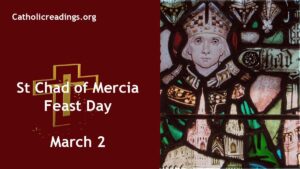St Chad, also known as Ceadda, was born in 634 AD in Northumbria and died on March 2 672 AD in Lichfield, Mercia, England. We celebrate his feast day on March 2 every year in the Catholic Church.
| St Chad of Mercia Biography | |
|---|---|
 |
|
| Date of Birth | 634 AD |
| Place of Birth | Northumbria |
| Profession | Abbot and bishop of of Mercia |
| Place of Work | England |
| Date of Death | March 2 672 |
| Place of Death | Lichfield, Mercia, England |
| Feast Day | March 2 |
| Canonization | Precongregation |
| Patron Saint of | |
St Chad of Mercia Life History
He was a monastic founder, abbot, and the initial bishop of Lichfield. He is recognized for his significant contribution to the Christianization of the historic English kingdom of Mercia.
St Chad and his brother, St. Cedd, received their education at the renowned Lindisfarne Abbey situated on Holy Island, off the coast of Northumbria. They were educated under the guidance of Abbot St. Aidan, the founder of the abbey.
Later, St. Chad is believed to have studied with St. Egbert, who was a monk at the Irish monastery of Rathmelsigi.
When St. Cedd needed help in founding the monastery of Laestingaeu (now Lastingham, North Yorkshire), he summoned St. Chad back to England.
After St. Cedd died in 664 AD, St. Chad succeeded him and became the second abbot of Laestingaeu.
Later that year, King Oswiu (Oswy) of Northumbria requested St. Chad to become the Bishop of the Northumbrians and to establish his see at York.
St. Chad was consecrated as the bishop of York, likely towards the end of 664 AD, at the request of the king.
Venerable Bede’s Ecclesiastical History of the English People, which is widely regarded as the most reliable source on the life of Chad, records the confusion that occurred when St. Wilfrid was selected as the bishop of York and went to Gaul for his consecration. This led to an ecclesiastical disagreement.
In 669 AD, when the new archbishop of Canterbury, St. Theodore, arrived in England, he accused Chad of irregular ordination. The matter continued to be unclear and unresolved.
When St. Wilfrid returned in 669 AD, Chad stepped down from his position as bishop of York and withdrew to Laestingaeu.
Nevertheless, St. Theodore was impressed with Chad’s modesty and when the bishop of Mercia died, he requested King Oswiu to choose Chad as the new bishop of Mercia.
King Oswiu gave his approval, and Chad, who had been re-ordained by St. Theodore in 669 AD, selected Lichfield as the new location for his diocese. He constructed a church and monastery there, making it the center of his ministry.
In the final three years of his life, Chad established a monastery in Lindsey. King Wulfhere of Mercia granted him the land on which the monastery was built.
Chad is believed to have also established another monastery in the same region, specifically at Barrow-upon-Humber.
Chad was recognized for his fervent ministry, frequently travelling on foot to spread his teachings. He died of plague, and various remarkable events were claimed to have occurred at his grave.
His remains, which were first held at Lichfield Cathedral, were rescued by Catholics during the Reformation and later transported to St. Chad’s Cathedral in Birmingham.
Related Links
Powered By SEO Experts
Follow @ReadingCatholic
